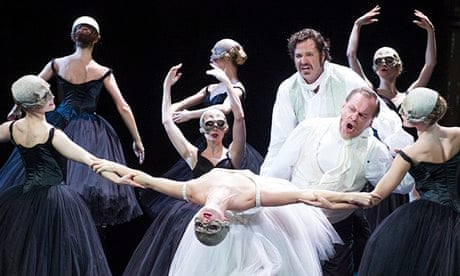If one term had to cover all eventualities in Les Vèpres siciliennes it would be "jolly rousing". Even in less familiar repertoire such as this, Verdi never lets you down. From ardent and vengeful choruses of Sicilian women and French soldiers to the heartfelt duets which structure this five-act work; from showpiece tenor arias to tripping woodwind ornament or dark, thudding brass; from decidedly awkward but impassioned father-and-son reunion to the wedding which is rudely interrupted by a massacre, all can be summed up without irony as, well, jolly rousing.
Anyone who risks sampling the Royal Opera's first staging of this lengthy work – better known in the later, Italian version as I vespri siciliani – will be rewarded by exciting singing and top orchestral playing under the baton of that matchless Verdi devotee, Antonio Pappano. The cast is dominated by men: the American tenor Bryan Hymel (Henri), who fearlessly hits nearly all his top notes bang centre and is creditable throughout; the German baritone Michael Volle (Montfort), whose voice grows more beguiling and powerful as the evening unfolds; and the Uruguayan bass Erwin Schrott, whose rich, velvety tones suit the role of the rebel Procida, even if with all that hair and a limp wrist he does look somewhat dandyish.
Lianna Haroutounian, in the one main female role of Hélène, had no shortage of dramatic vim but first-night intonation problems made for some nervous moments. Marina Poplavskaya takes over the part next week.
This being French grand opera, there's ballet too. Owing to personnel problems some time ago, the intended full-length ballet was dropped. This left several short dances, choreographed by Andre de Jong, and a corps of dancers eager to trip in like Gilbertian bridesmaids or the spare dance troupe in Ariadne auf Naxos at any given opportunity. They're credited in the programme as "freelance dancers", a woeful description. Let us not even try to imagine the embarrassment this must cause the ROH management, given the Royal Ballet shares the same building.
You have to be phlegmatic, too, about the production. Handsome on its own terms – the interior of the Paris Opera is recreated on the Royal Opera stage – it nevertheless grows more bizarre and kitsch as the action progresses. The plot is based on an event in the 13th century, but the Norwegian director Stefan Herheim and designer Philipp Fürhofer have updated it to 1855, the time of the opera's creation.
The look is Manet, with much black on black, and Degas. Apparently the "concept" concerns the battle of artists versus philistines. You would have thought that the French-Sicilian war of the original, and a sufficiently complicated interweaving of love, rape, politics and revenge, would have been enough already, but heigh-ho.
By the end, Schrott has appeared in glittering drag with skeleton mask, while a tiny gilded-winged child mimed the role of executioner and, in a clumsy finale, we watched "backstage" as a faux lighting rig blinded us before the final felling of the "set". Now under the spotlight, we the audience had become protagonists. Yes, that old cliche, along with rather too many others. But go and see it at Covent Garden, or at the cinema on 4 November, or listen on Radio 3 on 18 November. The great numbers – Procida's Palerme! O mon pays!, Monfort's Quand ma bonté toujours nouvelle and a string of vivid ensembles and choruses – will carry you through.
Top public honours tend not to be awarded to musicians who champion the new (otherwise why is Oliver Knussen still waiting for that knighthood?). One who deserves a gong, or some other accolade of his choosing, is Irvine Arditti, long-time leader of the quartet which takes his name. His 60th birthday was celebrated with a flurry of premieres at Wigmore Hall last week – a reminder both of his advocacy in bringing new works into existence and of his extraordinary virtuosity as a player.
Ranging from Brian Ferneyhough – the 1986 work Intermedio alla ciaccona (for solo violin) – to Francisco Guerrero and John Cage, the programme was as gritty and invigorating as a long session with a birch sauna whisk. Arditti, properly, had the spotlight in the Ferneyhough, in which explosions of energy and what the composer calls "close-ups of slowly evolving and monochrome textures" collide in a contrast of frenetic action and stasis.
UK premieres included Strings (Echo VII) (2008) by Robert HP Platz, in which each member of the quartet exists in their own space like glittering stars, playing from different areas of the hall. Hilda Paredes's Cuerdas del destino (2007-8), in four sections defined by harmony and tonal colour, made maximum use of glissando tremolo, pizzicato and col legno to jewelled effect. Akira Nishimura's Quartet No 5 "Shesha", written specifically for Arditti's birthday, took its title from a gigantic snake with thousands of heads and exploited both the lyrical and the often strident sounds of contemporary violin technique.
Occasionally private history has its place. I was once lucky enough to play in a Sunday-afternoon run-through of the Mendelssohn Octet with Irvine Arditti leading; as I recall, he had never played it before. Just as on that day he brought rigour and joy to the familiar sounds of the talented young Mendelssohn, so here on his birthday he found powerful lyricism and tenderness in the raw and the new.
Star ratings (out of 5):
Les Vèpres siciliennes ★★★
Arditti Quartet ★★★★

Comments (…)
Sign in or create your Guardian account to join the discussion